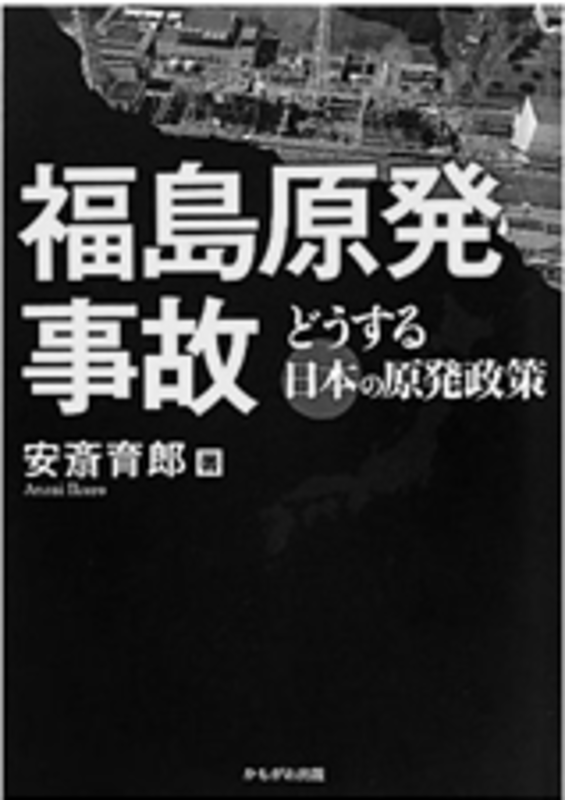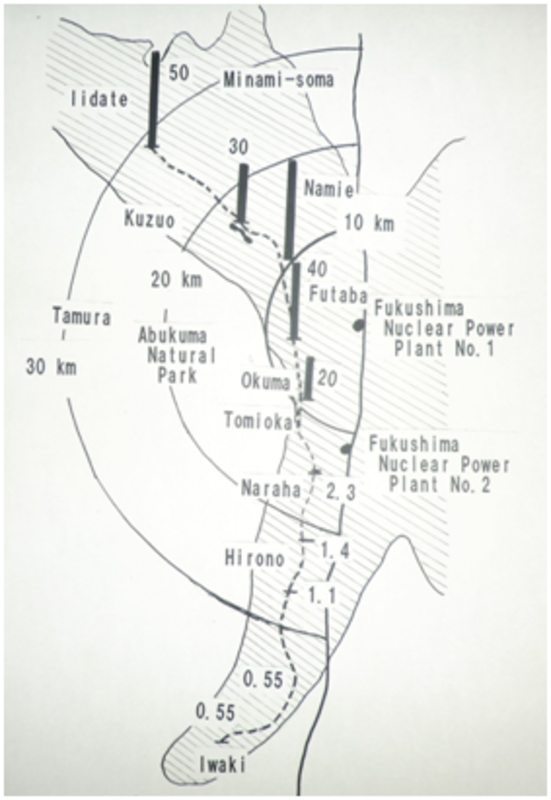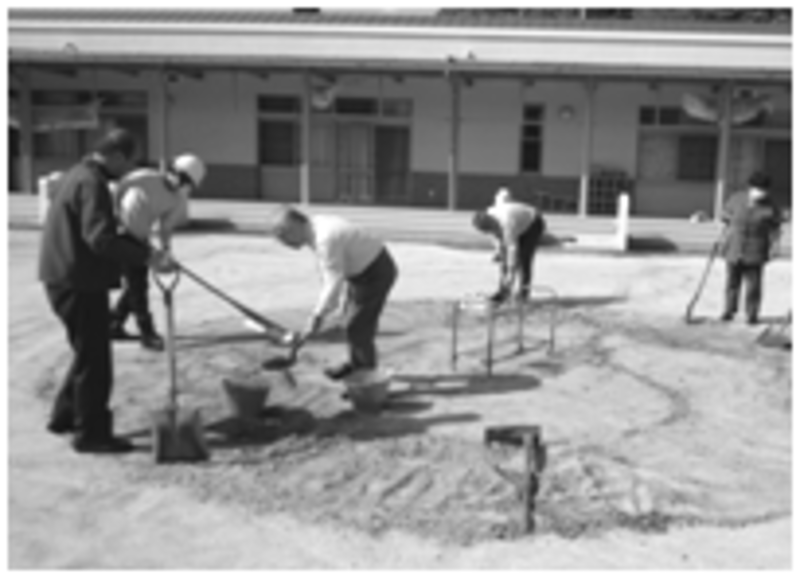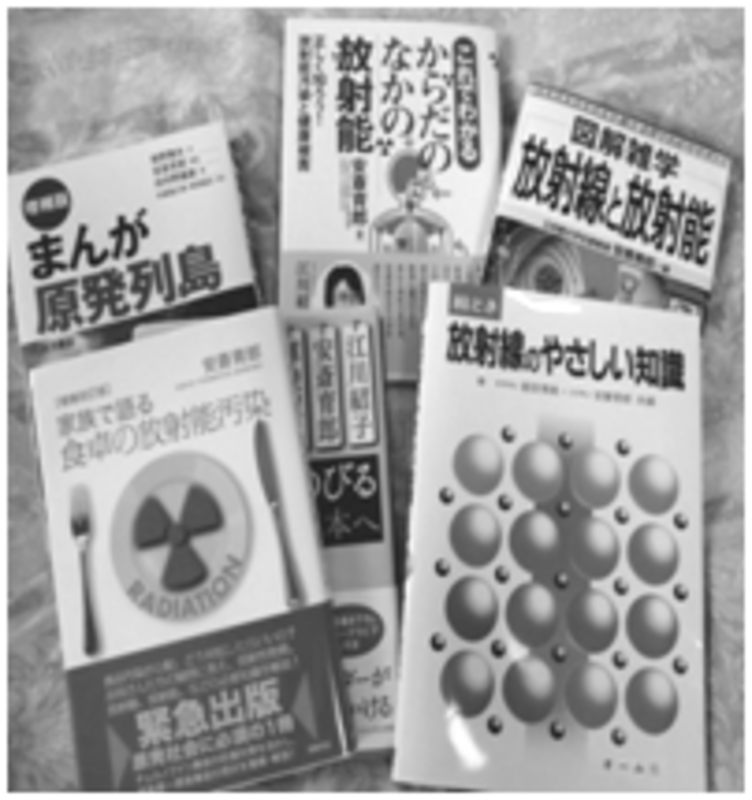An Agenda for Peace Research after 3/11 Japanese original text is available
Anzai Ikuro
A Japanese text addressing similar issues is available at Peace Philosophy Blog.
|
Professor Anzai sampling contaminated soil near Fukushima Nuclear Power Plant on 16 April 2011 |
At 14:46 on 11 March 2011, a tremendous earthquake occurred in Japan’s northeast (Tohoku), depriving approximately 28,000 people of their lives. More than 300,000 people took refuge from the quake, the following tsunami, and radiation originating from damaged nuclear power stations in the area. The magnitude of the quake was estimated to be 9.0, the biggest in Japan’s modern history “The Great East Japan Earthquake” was more than 11,000 times greater than the New Zealand Earthquake in Christchurch on 22 February 2011, and 45 times greater than the 1923 Great Kanto Earthquake in the Tokyo area which killed approximately 140,000 people.
When I learned about this serious nuclear accident that evening, I regretted not having been able to prevent such a catastrophe, although I am a specialist in radiation protection who has been criticizing governmental nuclear power policy since 1967. As a scientist involved in nuclear science and technology, I was ashamed of my incapacity to persuade the government and people of Japan of the risks of nuclear power generation, such as the Fukushima accident.
|
Hydrogen Gas Explosion Fukushima Devastation caused by Tsunami |
I graduated from the University of Tokyo in 1964 as one of the first students in the Department of Nuclear Engineering in Japan. My graduation paper was an investigation into preventive measures against severe nuclear accidents although there were no nuclear power plants in Japan at that time. As a result of the revised U.S.-Japan Security Treaty of 1960, Japan became deeply involved in the Vietnam War through military bases throughout the nation and especially in Okinawa. In addition to various new types of weapons such as the pineapple bomb, the ball bomb, the nail bomb, and defoliants, the U.S. military even had a plan to use hydrogen bombs, named B43, in Vietnam. Training to drop these bombs took place in Okinawa. One of the mock-up B43 bombs used for training is now exhibited at The Kyoto Museum for World Peace, Ritsumeikan University.
In 1965, the Japan Scientists Association was established to promote science based on the principles of independence, democracy and harmony. The association brought together researchers and educators not only in the physical and natural science but also in the social sciences and humanities. I joined the association in 1966, and became a board member responsible for monitoring nuclear power policy. I learnt comprehensively about nuclear issues, not only about the scientific and technological aspects but also the political, economic, social and cultural aspects of nuclear power policy. I was also educated by people in local communities who invited me to their meetings on nuclear safety, and posed numerous questions that were far outside my scientific expertise but were vital to the life of the community. These questions were extremely difficult for me to answer. In 1972 I was invited to deliver a keynote speech at the first symposium on nuclear power generation organized by the Science Council of Japan (JSC), which is sometimes referred to as the parliament of Japanese scientists. JSC is in effect the official representative organization of Japanese scientists. Two hundred and ten members of JSC, 30 scientists in 7 different fields, were elected by a direct vote of some 300,000 scientists from all over Japan. I was 32 years old at that time, and it was exceptional for a young scientist to deliver a keynote address on such a critical issue.
I proposed six fundamental check points concerning the health of Japanese nuclear power policy. These were (1) the independence of national energy policy; (2) development that placed safety above economic growth; (3) a national nuclear power policy that would not devastate local communities; (4) the prevention of military use of nuclear energy; (5) safety assurances to protect nuclear power plant workers and residents, and proven safety measures to prevent severe accidents; and (6) democracy of nuclear power administration. These points became leading principles for the anti-nuclear power movement in Japan in the 1970s.
In 1973, I was one of ten specialists invited to address the National Diet on nuclear science and technology . I took this opportunity to sharply criticize government policy on nuclear power. I was then an assistant lecturer in the Department of Radiological Health, in the Faculty of Medicine at the University of Tokyo, which is a national university. I was a national government employee who nevertheless criticized national nuclear policy. This resulted in academic harassments, which I will mention below.
In September of 1973, I became deeply involved in the anti-nuclear power movement in Fukushima together with people living in the vicinity of the nuclear power plants. The Government held a public hearing on Fukushima Nuclear Power Plant No. 2. It was the first official public hearing on nuclear power generation ever organized in Japan. But it was a typical example of “yarase”, meaning fakery or insincerity. The majority of speakers and the audience at the public hearing were proponents of bringing nuclear power plants to Fukushima. Nevertheless, I worked with scientists, lawyers and local residents to send delegates to the hearing to raise questions about the risks of nuclear power and to clarify the dangers of the national nuclear policy. Through the efforts of anti-nuclear residents, I was nominated as a delegate to speak on their behalf. The most astonishing thing was a speech made by a pro-nuclear woman who was sent from the local community in the vicinity of the Fukushima Nuclear Power Plants which are now in crisis. She said, “We need not fear bad effects from nuclear radiation because the 1973 champion in the All Japan Senior High School Baseball Tournament was from Hiroshima, the A-bombed city, where, it was once said, no grass or trees would grow for 75 years.” She seemed to suggest that radiation is not so harmful as feared by referring to the remarkable vitality of the young people who had grown up in an area devastated by a nuclear weapon. Unfortunately, such unscientific storytelling had some effect on the public acceptance of nuclear power.
Let me provide a brief history of nuclear power development in Japan. Immediately after the Pacific War, electric power in Japan was primarily generated by hydroelectric power plants, and the sole electric power company was “Japan Electric Power Generation and Supply Company”. While Japan was virtually ruled by the U.S. Occupation Army, it acted indirectly through the Japanese Government with Emperor Hirohito as a nominal symbol of the unity of the Japanese people. In 1951, the U.S. divided the state-run Japan Electric Power Generation and Supply Company into nine regional power companies including Tokyo Electric Company and Kansai Electric Company. Many of the new companies, such as Kansai Electric Company which served such big cities as Osaka, Kobe and Kyoto lacked sufficient hydraulic power resources to provide for the rapid development of the time. This made the company dependent upon thermal power plants. These plants initially relied on coal produced in Japan, but the fuel soon shifted to petroleum, which rendered Japan dependent on U.S. energy strategy. Nuclear power development in Japan likewise was based on accepting the offer of nuclear technology from the U.S. and introducing nuclear power plants developed in the U.S.
Yet Japan is the only nation that has experienced nuclear holocaust as a result of the U.S. atomic bombing of Hiroshima and Nagasaki in 1945. More than 300,000 people died as a result of nuclear weapons. But U.S. censors suppressed information about the terrible toll and after effects of the atomic bombings. On March 1, 1954, a Japanese tuna fishing boat, named Lucky Dragon # 5 was exposed to lethal levels of radioactive fallout produced by a U.S. hydrogen bomb test carried out on the Bikini Atolls. The detonation yield of that bomb was 15 megatons, five times as great as the total yield of bombs used in World War II including the two atomic bombs dropped on Hiroshima and Nagasaki. In 1961, the U.S.S.R. conducted a hydrogen bomb test nicknamed “Tsari Bomba” of 50 megatons. The 1950s and 60s were the peak periods of the U.S.-U.S.S.R. nuclear arms race based on the strategic policy of nuclear deterrence and the acquisition of a balance of power, which finally resulted in a policy known as “Mutually Assured Destruction” or MAD.
The Japanese anti-nuclear movement was ignited in 1954 in response to the March 1 U.S. hydrogen bomb test in Bikini. Two days later, at the initiative of Nakasone Yasuhiro, later Prime Minister, the Diet passed a budget of 235 million yen to build a nuclear reactor. The figure 235 came from uranium-235. The preceding year, Nakasone had taken part in a seminar held at Harvard to promote the “Atoms for Peace” project within the framework of U.S.-Japan cooperation. At that time, Shoriki Matsutaro, owner of the Yomiuri Newspaper Company, organized a series of traveling expositions to popularize the peaceful uses of nuclear energy. In 1959 I saw one such exposition in Tokyo. It included an actual nuclear reactor.
But it is worth recalling that the first practical nuclear power plant of 5,000 kws was built and went into operation in 1954 not in the U.S. but in Obnisk near Moscow. The U.S. Atomic Energy Act prohibited private enterprises from taking part in nuclear energy exploitation until its revision two months after the Soviet success in nuclear power generation. The U.S. then hastily developed nuclear power generation by making use of a nuclear reactor system developed for submarines, and opened the Shippingport Nuclear Power Plant in 1957. In that year, a report named WASH-740 and titled “Theoretical Possibilities and Consequences of Major Accidents in Large Nuclear Power Plants” indicated the possible effects of a “maximum credible accident” as 3,400 deaths, 43,000 injuries and property damage of 7 billion dollars, more than double the size of Japan’s national budget in those days. About half a year later, The Price-Anderson Nuclear Industries Indemnity Act decreed that private companies would be indemnified for any claims above 12.6 billion dollars (as of 2011). The Act was an essential incentive for private nuclear power. Four years later, a similar “Act for Indemnification of Nuclear Damage Compensation” was enacted in Japan. It is obvious that the nuclear power industry cannot survive such catastrophic situations without such support.
In Japan, the connection between government and the electric power companies was further strengthened by involving local government. “The Act on Tax for Promotion of Power Resources Development” generated vast subsidies, up to several billion yen for 3 years, for local governments that accepted a plan to build an electric power plant. Every contractor must pay about 5 dollars (375 yen) per 1,000 kw-h of electric power consumed, creating approximately 50 billion dollars in tax income for local governments. The local community can be blessed with a special subsidy for three years, but the infrastructure constructed subsequently requires costly maintenance. In this way, a cycle begins in which more nuclear power plants are apt to be invited.
Likewise, local residents were mobilized to promote nuclear power. For example, in Futaba District, Fukushima Prefecture, where nuclear disaster is now occurring, an “Organization to Building a Bright Futaba” was formed in the early 1970s. Its poster said “Let’s Promote Construction of Nuclear Power Plant by Our ‘Power’ and Open the Way to an Affluent Futaba”. People in the local communities thus joined a national mobilization for nuclear power.
|
Posters of a pro-nuclear organization in Fukushima promote nuclear power. The first is a poster made by the Science and Technology Agency in 1970 criticizes anti-nuclear people for having an “energy allergy.” Radiation levels in different locations in Fukushima. Figures are radiation exposure rates expressed in micro-Sieverts per hour. The ordinary level in Tokyo is 0.06~0.07 micro-Sievert per hour. Shaded portion signifies the area where internal radiation dose between 6 a.m. (March 12) and 0 a.m. (March 24) may have reached 100 milli-Sievert according to an estimate by the System for the Prediction of Environment Emergency Dose Information (SPEEDI). |
Needless to say, many nuclear engineering specialists were pressed to support the government’s views on the safety of nuclear power. Journalism, rather than playing a critical role, disseminated illusions and myths that nuclear power generation is safe and economical.
It is sometimes said that nuclear power generation in Japan has been promoted by a “pentagon” consisting of the central government, the nuclear power industry, local governments, specialists and journalists. I personally feel that residents’ organizations inviting nuclear power plants to local communities should be added to this “pentagon”, thereby forming a “hexagon” that is akin to the national mobilization structure constructed during the war. This hexagon forms a “nuclear village” which is closed, exclusive and relentless. I myself started student life as a member of this “nuclear village” in the early 1960s, but I was ruthlessly ejected from the village in the 1970s when I was identified as a dangerous critic of its policies.
After openly criticizing government nuclear policy in the early 1970s, I experienced extraordinary harassment at the University of Tokyo. I was excluded from the education system, and my research budget was eliminated. During lecture tours to various parts of Japan I was often tailed by a power company staff in charge of watching me. No one was permitted to talk to me from morning till evening. I experienced various types of obstruction in applying for a position at other colleges or universities.
I narrowly survived this very difficult time, first by my personal belief in life with dignity, second in solidarity with understanding people in the fields of science and public movements, and third, perhaps most importantly, through the support of my partner. Interestingly, the relationship with my boss slightly improved after the Three Mile Island accident in March 1979. He seemed to have understood that my warnings about the risks of nuclear power generation were not entirely false. But my position as an assistant lecturer remained frozen for 17 years until 1986, when I moved from the University of Tokyo to Ritsumeikan University.
Now I would like to comment on the situation in the radiation disaster area of Fukushima. I visited the area three times (mid-April, early May, and early August) after the accident of March 11th to visit friends with whom I have been working for a nuclear-risk-free community for about 40 years, to deliver several lectures for educators, citizens, workers, young mothers and specialists, to offer advice on radiation protection, and to measure radiation levels and sample soils contaminated with radioactive substances.
|
Donating a survey meter to an NGO |
The radiation levels have been and still are very high in nearby areas and within so-called hot spots, even in Fukushima City populated by about 280,000 residents some 60 km from the nuclear power plant. I conducted a radiation survey between Iwaki City and Namie Town, about 80 km apart, whose results are shown below. The radiation exposure rate was about 0.5 μSv/h in Iwaki, but it gradually rose up to 20, 30, or even to 50 μSv/h northwest of the nuclear power plant.
Radiation levels in Fukushima City differ from place to place, but, on average, the current exposure rate is about 1 micro-Sievert per hour at a height of 1 meter above ground, which is roughly equivalent to 150-200 chest X-ray examinations per year.
The major cause of external radiation exposure is radioactive cesium-137 deposited on the ground. The total amount of cesium-137 released from the Fukushima Nuclear Power Plants has been estimated to be about 168 times greater than that released by the Hiroshima A-bomb, according to the evaluation by the Ministry of Economics, Trade and Industry (METI). Most of these radioactive substances now deposited on the ground were released during the first week after the hydrogen gas explosions in the plant, with quite small amounts of radioactivity freshly coming down in recent days. It is noteworthy that radioactive cesium is highly absorbed in several centimeters of surface soil. In cooperation with Ms. Tanigawa Yoshiko, in early August I verified that cesium-137 does not easily dissolve in water, even when contaminated soil is washed with large quantities of water. This property is peculiar to the clay-like soil in Fukushima. This soil quality is the main reason why the levels of radioactive contamination of rice cropped this autumn in Fukushima were quite low. It also suggests that rainfall will not easily wash out radioactive cesium, and why sunflower may not effectively decontaminate the soil in Fukushima.
Therefore, in order to reduce radiation levels above the ground, it is quite effective to remove only a few centimeters of the surface soil layer. During my second visit to Fukushima in May, I conducted an experiment in a kindergarten in Fukushima City to demonstrate the effectiveness of surface soil clearance. The radiation level was remarkably lowered by removing just 2~3 centimeters of surface soil. The administrators of the kindergarten removed the contaminated surface soil thereafter, making it possible to have an outdoor event for children in early October.
|
Professor Anzai removing surface soil in a kindergarten. The graph shows a sharp reduction in radiation exposure rate by soil clearance. (horizontal axis: radius in meter) |
We must carry out every possible measure to protect people, especially young children, from harmful ionizing radiation nuclear power accidents. In Kyoto, electric power is generated by nuclear power plants only 60 kilometers from this conference venue. There are 14 nuclear power plants in Fukui Prefecture just adjacent to Kyoto, and vast amounts of high-level radioactive waste has already been accumulated. Future generations will have to isolate such dangerous nuclear waste over thousands of years. They will be required to expend huge resource to dispose of nuclear waste, which will produce no value for them. Even as we enjoy the fruits of nuclear power today, we are going to leave a tremendous “negative fortune” to our children, grandchildren, and future generations over tens of thousands of year. We must ask ourselves whether this is ethically justifiable.
I will conclude by raising several agenda items for peace researchers after 3/11. Based on my personal experience as a nuclear scientist specializing in radiation protection over 45 years and also as a peace researcher who has been confronting these unprecedented difficulties, I would like to suggest the following 5 points:
(1) Regarding the definition of peace, I fundamentally agree with Dr. Johan Galtung, and understand peace not only as an “absence of war” but also as an “absence of violence” which can be categorized into direct violence, structural violence and cultural violence. Although the enormous scale of the earthquake itself and the accompanying tsunami were of natural origin, we still observed a number of incidents of structural and cultural violence which aggravated the damage and pain of the sufferers in the devastated areas. It is the role of peace researchers to explain how the effects of an original natural disaster are further aggravated by interconnections of structural and/or cultural violence.
(2) An urgent agenda for several decades to come is to construct a comprehensive aid system for the people in disaster areas by integrating useful potentiality in politics, administration, economics, science, technology, and culture, including efforts toward decontamination of the living environment, adequate control of radioactive contamination of foods, dissemination of literacy about radiation and radioactivity for eradicating social discrimination and prejudice against sufferers, and establishment of a health check system to find and treat stochastic effects of radiation such as cancers and leukemia in the earliest stages. In order to integrate individual efforts into an effective total system, a peace-oriented coordination system must be established.
(3) An agenda for peace research suggested from my personal experience in academic life is to develop a method to sense dangerous social signs in the earliest stage, including signs in the fields of structural and/or cultural violence such as academic harassment, irrational policy execution without sincere attitude toward science, and destruction of democracy,. It may be helpful to develop some indicators such as the Global Peace Index, which was originated by the Institute for Economics and Peace (UK), or the Universal Human Rights Index of the UN Office of the High Commissioner for Human Rights. Such an indicator may help to warn people of this latent danger.
(4) Another peace research agenda is to elucidate the story of the Fukushima tragedy not only from the short-term point of view but also from a long-term perspective in world history. Efforts should be made to clarify the direct and indirect reasons why such a catastrophic nuclear disaster occurred in Japan by comprehensively analyzing and synthesizing historical facts in the light of, for example, subordination of Japanese politics to U.S. strategy in the postwar period and old-fashioned Japanese politics involving a taxation system for promoting nuclear power while manipulating public opinion. Lessons from such research may contribute to a more peaceful and safer future.
(5) Finally I propose an agenda that relates to the peace of future generations. This concerns radioactive waste disposal. How can we deal with consensus building about the acceptability of technologies, which may leave a massive “negative legacy”, such as the very long-lived nuclear waste which involves tremendous cost but produces no value for future generations? Peace researchers should be expected to answer the question: Is it ethically acceptable for us to enjoy nuclear energy in our lifetime while leaving behind hard-to-estimate risks to future generations with no possibility of obtaining their consent?
 |
Anzai Ikuro authored a number of books on nuclear power in the 1970s and 1980s, including Nuclear Power Generation in Japan (1974), Nuclear Power and the Environment (1975), Radioactivity in the Body (1979), Handbook of a Nuclear Power Plant Accident (1980). His recent books on nuclear energy issues include Fukushima Power Plant Accident, published by Kamogawa Shuppan in 2011.
This article is an abbreviated version of a Keynote Speech at the Opening Session of the 2011 International Conference of the Asia-Pacific Peace Research Association. See also his article in the Akita Youth Journal秋田青年広論.
Recommended citation: Anzai Ikuro, ‘An Agenda for Peace Research after 3/11,’ The Asia-Pacific Journal Vol 9, Issue 46 No 1, November 14, 2011.














